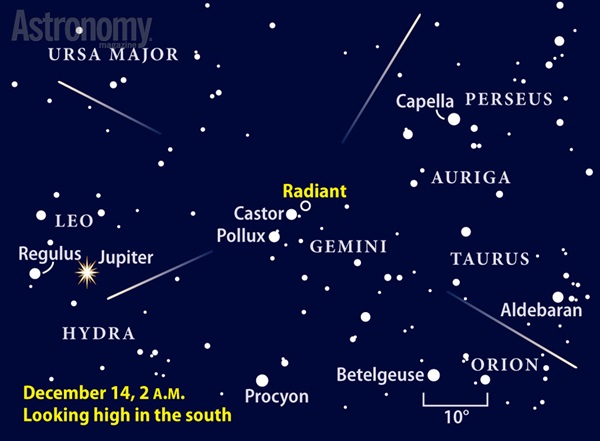Key Takeaways:
Most meteor showers occur as Earth runs into streams of particles shed by comets. The particles enter our atmosphere, burn up due to friction, and produce an incandescent column of light. The parent comet of the Lyrid shower is Comet Thatcher (C/1861 G1), which orbits the Sun every 415 years. This year, the Lyrid meteor shower will be active from April 16 through the 25th with the peak occurring in the hours before dawn April 23.
Astronomers evaluate meteor shower strengths by their hourly rates. The Lyrids typically deliver between 15 and 20 meteors per hour at their peak for observers at dark sites, which generally means 30 miles (50 kilometers) from city lights. This year could be better than average, however. Some meteor scientists predict enhanced rates in 2015, so it could pay dividends to be watching before dawn April 23.
The shower’s radiant — the point from which the meteors appear to emanate — lies in the constellation Lyra near that group’s brightest star, Vega (Alpha [α] Lyrae). The radiant passes nearly overhead just before dawn.
Viewers need no special equipment or optics. In fact, the eyes alone work best because they offer the largest possible field of view. A reclining lawn chair will help with comfort, as will a blanket and a warm (non-alcoholic) beverage.
Interesting facts about meteors
- To be visible, a meteor must be within about 120 miles (200 kilometers) of an observer.
- Meteors become visible at an average height of 55 miles (90km). Nearly all burn up before they reach an altitude of 50 miles (80km).
- The typical bright meteor is produced by a particle with a mass less than 1 gram with a size no larger than a pea.
- The hourly rate on a “non-shower” night is approximately six meteors per hour.
- A meteoroid enters the atmosphere at a velocity between 50,000 and 165,000 mph (81,000 and 265,000 km/h).
- Video: How to observe meteor showers, with Michael E. Bakich, senior editor
- Video: Easy-to-Find Objects in the 2015 Spring Sky, with Michael E. Bakich, senior editor
- StarDome: Locate the shower’s radiant in Lyra in your night sky with our interactive star chart.
- The Sky this Week: Get your meteor shower info from a daily digest of celestial events coming soon to a sky near you.
- Sign up for our free weekly email newsletter.












